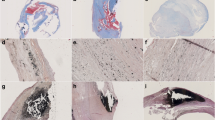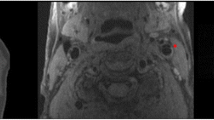Abstract
Purpose
Calcification pathogenesis and the relationship between calcification and plaque composition remain unclear. This study explored the calcification characteristics of vulnerable plaques, especially focusing on calcification thickness, using computed tomography angiography and magnetic resonance plaque imaging.
Methods
Demographic, computed tomography angiography, and magnetic resonance plaque imaging data were acquired from 178 patients with 229 lesions diagnosed with carotid stenosis. The calcification types were categorized by calcification thickness. We evaluated their features, including the anatomical location and the plaque composition compared with MR plaque imaging, and clarify the clinical characteristics. Furthermore, an immunohistochemical subgroup analysis was performed on 84 lesions treated with carotid endarterectomy.
Results
The result of the ROC analysis suggested the threshold between symptomatic and asymptomatic calcification was 2.04 mm (AUC;0.841, 95%CI; 0.771–0.894). Calcification with ≥ 2 mm thickness was classified as thick calcification and < 2 mm thickness as thin calcification. Multivariate analysis suggested the prevalence of symptomatic patients in the thin calcification group was significantly higher than others (P = 0.01; odds ratio, 4.1; 95% confidence interval 2.8–7.2). Plaques with thin calcification were associated with plaque with intraplaque hemorrhage (P < 0.01). The interobserver reliability (κ) of calcification type was 0.962 (95% confidence interval, 0.941–0.988). Immunohistochemical analysis demonstrated that the numbers of CD68-positive cells and CD31-positive microvessels in shoulder lesions were significantly higher in the thin calcification group than in the non-thin group (both P < 0.01).
Conclusions
Thin calcification was associated with plaques with intraplaque hemorrhage and had different clinical implications than thick calcification.







Similar content being viewed by others
References
Murray CJ, Vos T, Lozano R, Naghavi M, Flaxman AD, Michaud C et al (2012) Disability-adjusted life years (DALYs) for 291 diseases and injuries in 21 regions, 1990–2010: a systematic analysis for the Global Burden of Disease Study 2010. Lancet 380:2197–223
Petty GW, Brown RD Jr, Whisnant JP, Sicks JD, O’Fallon WM, Wiebers DO (1999) Ischemic stroke subtypes: a population-based study of incidence and risk factors. Stroke 30:2513–6
Azuma M, Maekawa K, Yamashita A, Yokogami K, Enzaki M, Khant ZA et al (2020) Characterization of carotid plaque components by quantitative susceptibility mapping. AJNR Am J Neuroradiol 41:310–7
Brinjikji W, Huston J 3rd, Rabinstein AA, Kim GM, Lerman A, Lanzino G (2016) Contemporary carotid imaging: from degree of stenosis to plaque vulnerability. J Neurosurg 124:27–42
Kashiwazaki D, Akioka N, Kuwayama N, Noguchi K, Tanaka K, Kuroda S. Pathophysiology of acute cerebrovascular syndrome in patients with carotid artery stenosis: a magnetic resonance imaging/single-photon emission computed tomography study(2015).Neurosurgery;76:427-33; discussion 33-4.
Hayden MR, Tyagi SC, Kolb L, Sowers JR, Khanna R (2005) Vascular ossification-calcification in metabolic syndrome, type 2 diabetes mellitus, chronic kidney disease, and calciphylaxis-calcific uremic arteriolopathy: the emerging role of sodium thiosulfate. Cardiovasc Diabetol 4:4
Eisenmenger LB, Aldred BW, Kim SE, Stoddard GJ, de Havenon A, Treiman GS et al (2016) Prediction of carotid intraplaque hemorrhage using adventitial calcification and plaque thickness on CTA. AJNR Am J Neuroradiol 37:1496–503
Katano H, Mase M, Nishikawa Y, Yamada H, Yamada K (2017) Analysis of Recurrent stenosis after carotid endarterectomy featuring primary plaque calcification. Neurosurgery 80:863–70
Niwa Y, Katano H, Yamada K (2004) Calcification in carotid atheromatous plaque: delineation by 3D-CT angiography, compared with pathological findings. Neurol Res 26:778–84
Halliday A, Mansfield A, Marro J, Peto C, Peto R, Potter J et al (2004) Prevention of disabling and fatal strokes by successful carotid endarterectomy in patients without recent neurological symptoms: randomised controlled trial. Lancet 363:1491–502
North american symptomatic carotid endarterectomy trial C, Barnett HJM, Taylor DW, Haynes RB, Sackett DL, Peerless SJ et al (1991) Beneficial effect of carotid endarterectomy in symptomatic patients with high-grade carotid stenosis. N Engl J Med 325:445–53
Kashiwazaki D, Yamamoto S, Akioka N, Hori E, Shibata T, Kuwayama N et al (2021) Dilated microvessel with endothelial cell proliferation involves intraplaque hemorrhage in unstable carotid plaque. Acta Neurochir (Wien) 163:1777–85
Li W, Xu LH, Forssell C, Sullivan JL, Yuan XM (2008) Overexpression of transferrin receptor and ferritin related to clinical symptoms and destabilization of human carotid plaques. Exp Biol Med (Maywood) 233:818–26
Kashiwazaki D, Akioka N, Kuwayama N, Hayashi T, Noguchi K, Tanaka K et al (2016) Involvement of circulating endothelial progenitor cells in carotid plaque growth and vulnerability. J Neurosurg 125:1549–56
Schindler A, Schinner R, Altaf N, Hosseini AA, Simpson RJ, Esposito-Bauer L et al (2020) Prediction of stroke risk by detection of hemorrhage in carotid plaques: meta-analysis of individual patient data. JACC Cardiovasc Imaging 13:395–406
Takaya N, Yuan C, Chu B, Saam T, Underhill H, Cai J et al (2006) Association between carotid plaque characteristics and subsequent ischemic cerebrovascular events: a prospective assessment with MRI–initial results. Stroke 37:818–23
Nadra I, Mason JC, Philippidis P, Florey O, Smythe CD, McCarthy GM et al (2005) Proinflammatory activation of macrophages by basic calcium phosphate crystals via protein kinase C and MAP kinase pathways: a vicious cycle of inflammation and arterial calcification? Circ Res 96:1248–56
Thrysoe SA, Oikawa M, Yuan C, Eldrup N, Klaerke A, Paaske WP et al (2010) Longitudinal distribution of mechanical stresses in carotid plaques of symptomatic patients. Stroke 41:1041–3
Sakamoto S, Kiura Y, Okazaki T, Shinagawa K, Ishii D, Ichinose N et al (2016) Carotid artery stenting for vulnerable plaques on MR angiography and ultrasonography: utility of dual protection and blood aspiration method. J Neurointerv Surg 8:1011–5
Yamada K, Kawasaki M, Yoshimura S, Enomoto Y, Asano T, Minatoguchi S et al (2010) Prediction of silent ischemic lesions after carotid artery stenting using integrated backscatter ultrasound and magnetic resonance imaging. Atherosclerosis 208:161–6
Gossl M, Versari D, Hildebrandt HA, Bajanowski T, Sangiorgi G, Erbel R et al (2010) Segmental heterogeneity of vasa vasorum neovascularization in human coronary atherosclerosis. JACC Cardiovasc Imaging 3:32–40
Dykun I, Lehmann N, Kalsch H, Mohlenkamp S, Moebus S, Budde T et al (2016) Statin medication enhances progression of coronary artery calcification: the heinz nixdorf recall study. J Am Coll Cardiol 68:2123–5
Karlof E, Seime T, Dias N, Lengquist M, Witasp A, Almqvist H et al (2019) Correlation of computed tomography with carotid plaque transcriptomes associates calcification with lesion-stabilization. Atherosclerosis 288:175–85
Author information
Authors and Affiliations
Corresponding author
Ethics declarations
Ethics approval
This study was approved by the Institutional Review Board of our institution, which waived the written informed consent requirement given the retrospective nature of the study.
Conflict of interest
The authors declare no competing interests.
Additional information
Publisher's Note
Springer Nature remains neutral with regard to jurisdictional claims in published maps and institutional affiliations.
Rights and permissions
About this article
Cite this article
Kashiwazaki, D., Yamamoto, S., Hori, E. et al. Thin calcification (< 2 mm) can highly predict intraplaque hemorrhage in carotid plaque: the clinical significance of calcification types. Acta Neurochir 164, 1635–1643 (2022). https://doi.org/10.1007/s00701-022-05205-x
Received:
Accepted:
Published:
Issue Date:
DOI: https://doi.org/10.1007/s00701-022-05205-x




